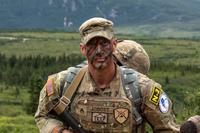The Army is seeking public comments on a draft environmental impact statement it released Friday for its proposed retention of up to 6,322 acres of state-owned lands it uses for training on Oahu.
Leases begin expiring in 2029 at Kahuku Training Area, Kawailoa-Poamoho Training Area and Makua Military Reservation.
According to the draft, Oahu training areas provide approximately 30% of the Army training land in Hawaii “and represent a substantial portion of the maneuver training land, located away from populated areas to ensure soldier and public safety, within the austere jungle training environments required … to maintain Army readiness.”
The state-owned lands include 1,150 acres at Kahuku, 4,390 acres at Poamoho and 782 acres at Makua that are used by the Army, Marine Corps and Hawaii National Guard. Without an agreement with the state, the Army loses it all. As tensions rise with China, the military is under pressure to retain the lands for training. But they are also negotiating at a time when many Hawaii residents and officials have been rethinking their relationship with the military — which leased the land in the 1960s for a mere $1.
The Army listed nine options referred to as “alternatives.”
Under alternative No. 1, the Army would retain all state-owned lands within KTA, Poamoho and MMR.
Under alternative No. 2 — which the draft said is the Army’s preferred option — the military would retain all state-owned lands within the training areas “except land on which limited training occurs and where Army natural resources conservation management actions are not required to support sustainable training.” Under that alternative the Army would give up most of Makua’s makai portions west of Farrington Highway.
Under the other alternatives the Army makes various other concessions, but the most radical are the remaining three, which the draft said “were identified by members of the public during the scoping period for this EIS,” some of which included no retention and returning land to the state.
The most contentious of the lands is Makua. Once a small but thriving farming community, the military began using parts of Makua Valley for live-fire training in the 1920s when the islands were governed as a U.S. territory. But after the Japanese navy’s surprise attack on Dec. 7, 1941, the military imposed martial law in Hawaii and took control of Makua.
Army officials promised it was temporary. Local farmers displaced by the training were told most would be able to return when the war was over. But in 1945, World War II ended and the Cold War began, and the military asked Hawaii’s territorial government for the transfer of 6,608 acres at Makua for training. The Army has been there ever since.
The draft said that “MMR is essential to the Army’s ongoing training missions, providing maneuver training areas, aviation capabilities, special use airspace (SUA), transportation network, and utilities.” It also said that Makua “also has combined live-fire capability that is not currently being used” but that due to “foreseeable training requirements, and recent changes to Army force structure, the Army has determined that it will not pursue live-fire training at MMR. It is therefore not reasonably foreseeable and is not analyzed in this EIS.”
The Army hasn’t actually fired a shot there since 2004 after a lawsuit by Earthjustice on behalf of activist group Malama Makua brought an end to live-fire training. In October, U.S. Army Pacific leadership signed a memorandum stating there are no plans to resume that training, and in a joint statement submitted to Hawaii’s federal district court in December, U.S. Defense Secretary Lloyd Austin and U.S. Secretary of the Army Christine Wormuth said the military would “no longer need to conduct live-fire training at MMR, now or in the future, and, therefore, no new (unexploded ordnance) will be added to MMR.”
Vince Dodge, a member of Malama Makua, said he and much of the organization have yet to review the draft but that he was “not surprised” to see the Army ask to retain most of Makua. But he added, “Our sense is that this is sort of their process of negotiation.” He said, “I can just see them saying, ‘Well, we’ll start with the beach and see who goes through that. If we have to give a little bit more, we’ll give a little bit more, you know, maybe ultimately give the whole thing back.’”
“Their reasoning for keeping Makua so they can train with helicopters and unmanned drones is really weak, because they can do that at Schofield, they can do that in other places,” Dodge explained. “They don’t need Makua, and the talk has been that they will give up Makua — but that they want to give up Makua so they can keep everything else.”
The Army will hold public meetings at the Waianae District Park Multi-Purpose Room on July 9, Kahuku High and Intermediate School on July 10 and Leilehua High School on July 11. All comments must be postmarked or received by 11:59 p.m. Aug. 7 for the final EIS, which can be read at bit.ly/4bNa34n.
Written comments can be submitted through the aforementioned website, emailed to atlr-oahu-eis@g70.design or mailed to O‘ahu ATLR EIS Comments, P.O. Box 3444, Honolulu, HI 96801-3444.
___
(c)2024 The Honolulu Star-Advertiser
Visit The Honolulu Star-Advertiser at www.staradvertiser.com
Distributed by Tribune Content Agency, LLC.











